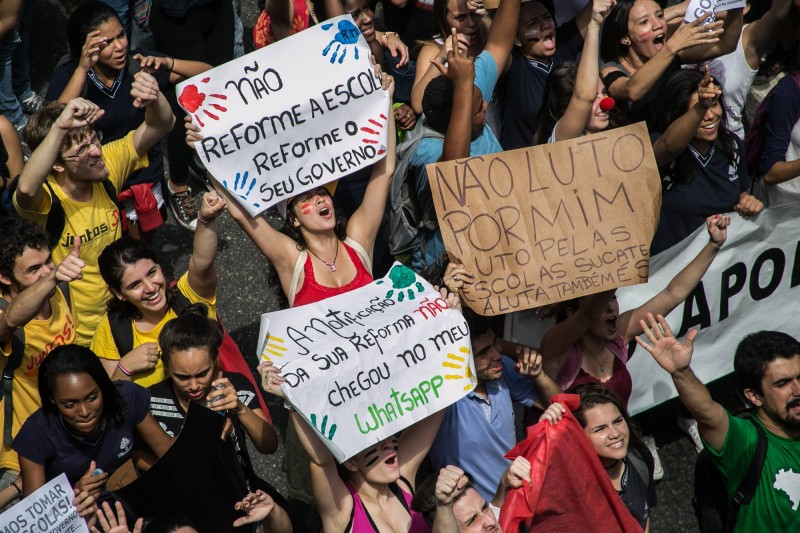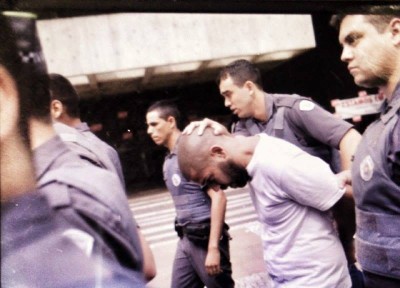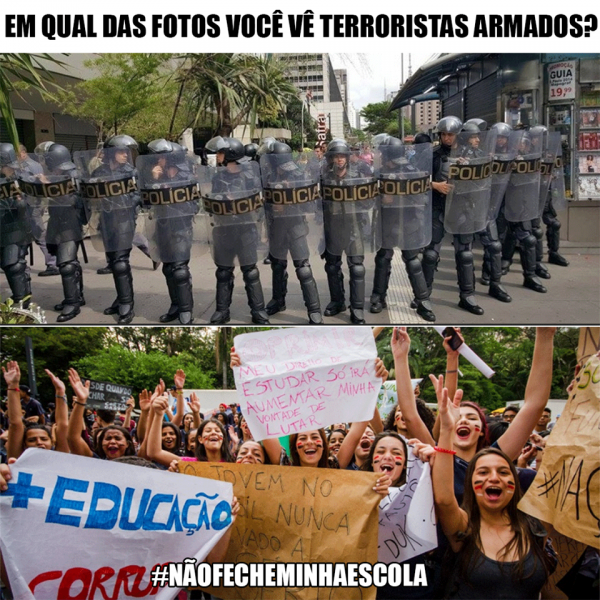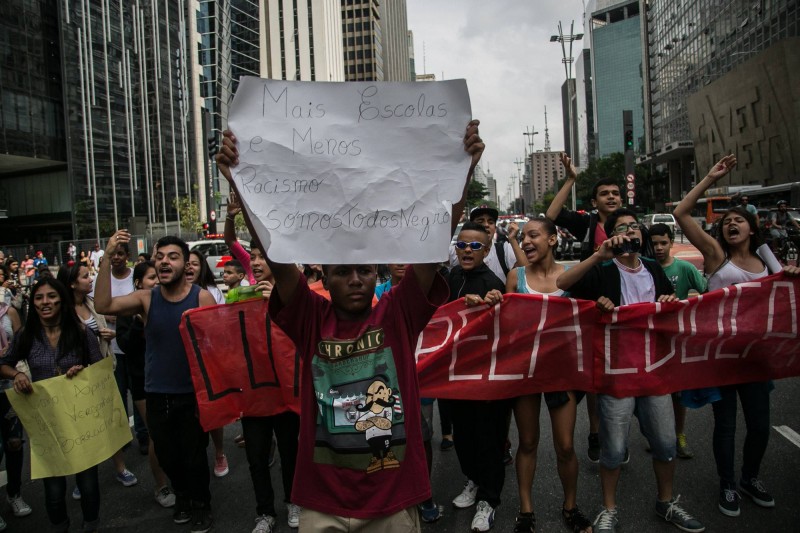
Students protest in São Paulo. Photo by Mídia Ninja
Thousands of students took to Paulista Avenue in São Paulo on October 9, 2015, to protest against the possible shutting down of hundreds of state schools and relocation of students within the district. According to the protest's organizers, at least 5,000 students were in the streets. Police responded with a heavy hand and four people were arrested — among them, a teacher and a photographer.
The proposal, announced by the state governor Geraldo Alckmin, displeased students, parents and teachers, who marched against the government's refusal to negotiate alternatives. Students also protested in other parts of the capital São Paulo as well as other cities in the state, such as Osasco, Ribeirão Preto and São Bernardo, but in these cities there was no police aggression.
With the restructuring proposed by the government, schools will offer only one of the three levels of education in the Brazilian system, instead of offering primary through secondary education all under the same roof. In Brazil, basic education is divided into three cycles: 1st to 5th grade, 6th to 9th grade (both called elementary school) and the final three years (“high school”).
Currently, many public schools in São Paulo offer more than one cycle, but that would end under the new plan. According to the Department of Education, up to a thousand schools and about two million students could be affected by the measure.
State authorities say the restructuring is due to the decrease in São Paulo's population of school age throughout the last several years — according to the Department of Education, the state system has lost 2 million students since 1998. But experts argue the changes are simply budget cuts by a different name.

Photographer Caio Castor is detained by the police. Photo by Rafael Vilela / Mídia Ninja.
Journalist Antônio Martins explained the consequences of the proposal:
A “reorganização” pretende eliminar a possibilidade de uma escola oferecer, ao mesmo tempo, vagas no ensino fundamental e médio. Nenhuma justificativa pedagógica é apresentada para esta cisão. As implicações, porém, tem caráter claramente discriminatório.
Os alunos das unidades que deixarem de atender ao grau de ensino em que estão serão transferidos. Só terão vagas asseguradas em escolas localizadas a até 1,5 km de suas residências. Isso obrigará centenas de milhares de jovens da periferia a deixarem escolas centrais — normalmente melhor estruturadas e equipadas. Estas, em muitos casos, fecharão por falta de procura, já que nas regiões próximas aos centros, a população têm idade média mais alta e tende a procurar o ensino privado. Ao invés de melhorar a qualidade do ensino em toda a rede estadual, para atrair este público, o governo Alckmin parece interessado em descartar suas melhores unidades.
The “reorganization” intends to eliminate the possibility for a school to offer, simultaneously, places in both elementary and high school. No pedagogical justification is given for the split. The implications, however, have a clearly discriminatory bias to it.
Students at schools which will cease to provide their level of education will be transferred. They will only have guaranteed seats in schools located up to 1.5 kilometers from their homes. This will force hundreds of thousands of young people from the suburbs to leave central schools — usually better structured and equipped. Those, in many cases, will close due to lack of demand, since in the central regions the population's average age is higher and tend to seek private education. Instead of improving the quality of education of the whole state system, precisely to attract this audience, it seems that the Alckmin government is interested in getting rid of its best schools.
For example, imagine a student residing in the suburbs who is starting 6th grade in 2016 at a school in the central region. With the restructuring, that school will cease to offer the second cycle, and the student will have to transfer — and he or she will only have a guaranteed place at a school in the outskirts of the city.
In Brazil, the majority of students attending public schools come from low-income families (as a result, many of them reside in the outskirts of Brazilian's large cities), while upper middle-class families tend to enroll their children in private schools.

Mashup made by the Iconoclastia Incendiária page on Facebook in protest against the governor of São Paulo, Geraldo Alckmin. The image reads: “Then I'll get your dreams and your future and crush it like this”
The Facebook page “Não fechem minha escola” (Don't close my school), created earlier this month after the announcement of the reorganization, posted several photos of the demonstration this week at Avenida Paulista.
‘Yet more arbitrariness from Alckmin's police’
Collective Território Livre (Free Territory), which covered the demonstration, released a video on Facebook that shows when police began to rush into the crowd, batons in hand, and go after a particular protester, shoving others out of the way.
And they also explained:
O vídeo prova que a PM começou o conflito de forma totalmente gratuita, arrancando uma máscara laranja de um jovem (máscara que nem cobria o rosto dele de verdade). Desde quando é crime colocar uma máscara na cara? O intuito da PM era provocar e dividir o ato em dois, para ter maior controle. Provocar para acabar com o ato, essa era a tática de hoje. Foi assim que o governador mandou seus homens agirem.
No vídeo é possível ver também a agressão fortuita ao fotógrafo Caio Castor, que estava cobrindo o ato a trabalho e acabou preso (em outro video mostramos o momento da sua prisão). Fora Alckmin, inimigo da juventude!Não ao fechamento das escolas! Ocupar, se quiserem fechar! Viva a luta dos secundaristas!
The video proves that the military police started the conflict without provocation, yanking a young student's orange mask (which didn't even really cover his face). Since when is it a crime to put a mask on your face? The military police's intention was to provoke and divide the demonstration in two for greater control. Provoke to end the demonstration — that was the tactic today. This is how the governor sent his men to act.
In the video you can also see the random assault against photographer Caio Castor, who was covering the demonstration and was arrested (in another video we showed the momen of his arrest). Alckmin out, enemy of young people! No to the closing of schools! Occupy if they want to close! Long live the struggle of the students!
Activist Igor Carvalho denounced Castor‘s arrest; the photojournalist was later released by police:
O companheiro Caio foi preso agora pela manhã quando exercia o livre direito de registrar a, sempre violenta, ação policial, durante os protestos contra o fechamento das escolas estaduais em SP. Mais uma arbitrariedade da polícia do Alckmin.
Our comrade Caio was arrested this morning when exercising his right to freely register the always violent police actions during the protests against the closure of state schools in São Paulo. Yet more arbitrariness from Alckmin's police.
Território Livre posted the moment of Castor's arrest. The footage shows him on the ground, surrounded by police. One of the officers has his arms locked around Castor's neck, restraining him:
O fotógrafo estava a trabalho, cobrindo o ato dos estudantes secundaristas contra o fechamento das escolas por Alckmin. Por que a PM optou por prender apenas um professor e um fotógrafo? Isso foi deliberado. Prender menor de idade dá muita dor de cabeça e pega muito mal. Por isso a PM optou por causar para prender de forma totalmente gratuita alguns maiores de idade. Assim ela tenta botar medo nos menores de idade. O fotógrafo Caio já havia sido esganado por um policial momentos antes (veja video do início do conflito). Abaixo a ditadura! Viva a luta da juventude! Não ao fechamento das escolas!
The photographer was working, covering the demonstration of high school students against the closure of schools promoted by Alckmin. Why did the military police choose to arrest only a teacher and a photographer? That was deliberate. Arresting underage people brings a lot of headaches and makes the police look bad. So the military police chose to make a scene in order to arrest people of legal age. So they try to put fear in the minors. The photographer Caio had been strangled by a police officer moments before his detainment (see video of the start of the conflict). Down with the dictatorship! Long live the struggle of the youth! No closing of schools!
Castor also recorded when police began to lash out from another angle, and his camera captured the moment he was arrested.
Sociology professor Luis Carlos de Melo was also arrested during the demonstration as the video from the same collective shows. In total, four people were arrested.
‘Because he is black’

The DAR – Desentorpecer a Razão collective questioned the police action against the students. The image reads: “In which of the photos do you see armed terrorists?”
Amanda Gomes Lemos, a journalism student who also covered the protest, questioned the police about the reasons for the arrests and aggression:
Em certo momento, resolveram atacar um garoto em específico. Resolvi perguntar aos policiais o motivo da agressão e a resposta foi: “ele está cobrindo o rosto com uma bandana”.
Eu, que também estava de bandana vermelha para evitar efeitos de possíveis bombas de gás lacrimogênio, respondi: “Por quê? Eu também estou do mesmo jeito e vocês não estão me agredindo”.
O policial, sorrindo, explicitou: “porque ele é negro”.
At one point, they decided to attack a boy in particular. I decided to ask the police the reason for this and the response was: “He is covering his face with a bandana.”
I, who was also wearing a red bandana to avoid possible effects of tear gas, replied, “Why?, I'm also wearing it but you are not attacking me.”
The officer, smiling, explained: “Because he is black.”

Students protest in São Paulo. Photo by Midia Ninja. The poster reads: “More schools, less racism. We are all blacks.”
New demonstrations have been called for against both the closure of schools and police repression of the right to protest.







1 comment
Students have taken enormous decision to protest against governments closure to public schools. These students are looking great. However, protest should go on as long as government determines their decisions…